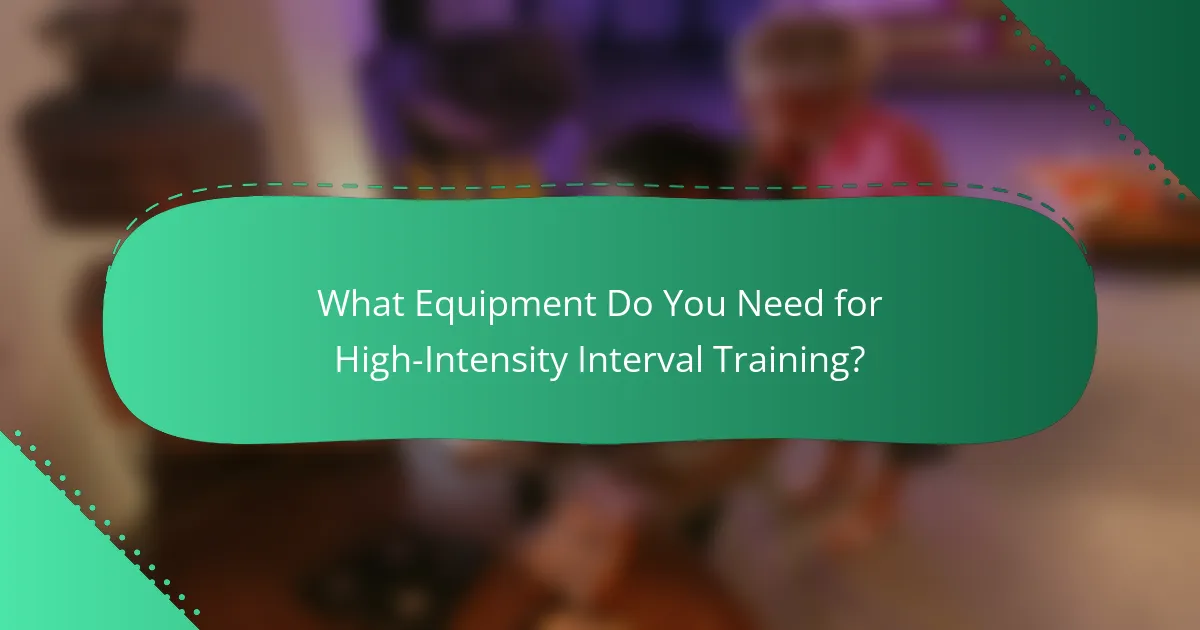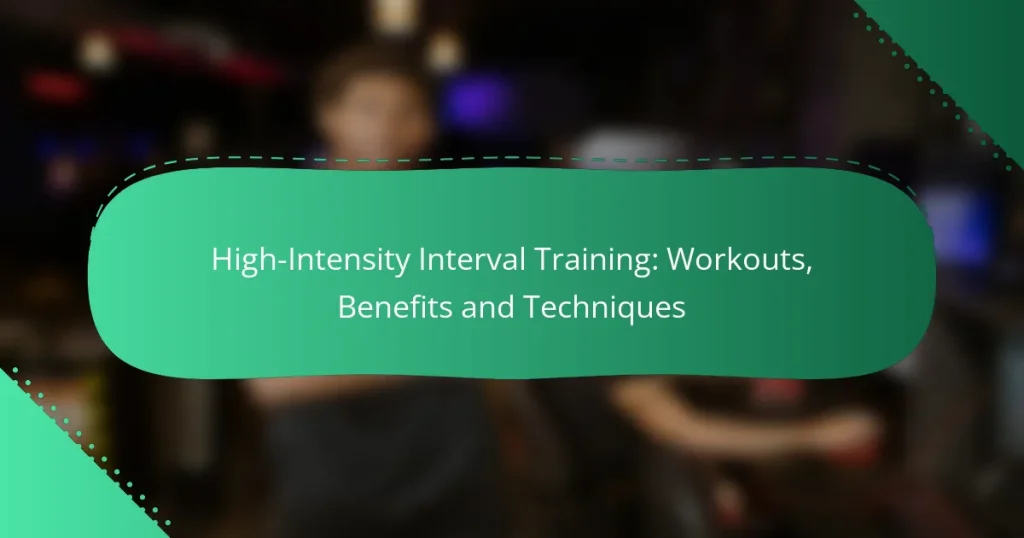High-Intensity Interval Training (HIIT) is a dynamic workout approach that alternates between intense bursts of exercise and periods of rest or lower intensity. This training method not only enhances cardiovascular health and boosts metabolic rates but also helps in building muscle tone, making it an efficient choice for those with limited time. By tailoring workouts to individual goals and fitness levels, HIIT can be adapted to suit a wide range of preferences and abilities.

What Are the Best High-Intensity Interval Training Workouts?
The best high-intensity interval training (HIIT) workouts vary based on individual goals and preferences, but they generally include structured bursts of intense exercise followed by rest or low-intensity periods. Popular HIIT formats like Tabata, Fartlek, and Circuit Training cater to different fitness levels and can be done with minimal equipment.
Tabata Training
Tabata training is a specific form of HIIT that consists of 20 seconds of maximum effort followed by 10 seconds of rest, repeated for eight rounds, totaling four minutes. This method is effective for improving both aerobic and anaerobic fitness and can be applied to various exercises such as squats, burpees, or cycling.
To implement Tabata, choose an exercise, set a timer, and push yourself during the work intervals. Ensure proper form to prevent injury, and consider starting with two to three rounds before progressing to the full eight rounds.
Fartlek Training
Fartlek training combines continuous running with intervals of varying intensity, allowing for a more flexible approach to HIIT. It involves alternating between fast-paced sprints and slower recovery periods, making it suitable for runners looking to enhance speed and endurance.
To practice Fartlek, select a route and decide on landmarks to sprint towards, followed by slower jogging until you reach the next landmark. This method can be easily adjusted based on fitness levels and can be done outdoors or on a treadmill.
Circuit Training
Circuit training involves a series of exercises performed in sequence with minimal rest in between, targeting different muscle groups. This format can include bodyweight exercises, resistance training, or cardio, making it versatile and effective for overall fitness improvement.
To create a circuit, choose 5-10 exercises, such as push-ups, lunges, and jumping jacks, and perform each for a set time (e.g., 30 seconds) before moving to the next. Aim for 2-4 circuits with a short rest between each round to maximize benefits.
Bodyweight HIIT
Bodyweight HIIT workouts utilize your own weight for resistance, eliminating the need for equipment. This approach is accessible and can be done anywhere, making it ideal for those who prefer home workouts or are just starting their fitness journey.
Examples of bodyweight HIIT exercises include mountain climbers, high knees, and planks. Structure your workout with intervals of 30 seconds of work followed by 15 seconds of rest, repeating for 20-30 minutes for an effective session.
HIIT with Weights
HIIT with weights incorporates resistance training into high-intensity intervals, enhancing muscle strength while improving cardiovascular fitness. This method is beneficial for those looking to build muscle and burn fat simultaneously.
Choose compound movements like deadlifts, kettlebell swings, or dumbbell thrusters, and perform them in intervals of 30-45 seconds of work followed by 15-30 seconds of rest. Ensure proper technique to avoid injury and consider starting with lighter weights to master the movements before increasing resistance.

What Are the Benefits of High-Intensity Interval Training?
High-Intensity Interval Training (HIIT) offers numerous benefits, including improved cardiovascular health, increased metabolic rate, and enhanced muscle tone. These advantages make HIIT an effective workout option for those looking to maximize their fitness in a shorter time frame.
Improved Cardiovascular Health
HIIT significantly boosts cardiovascular health by increasing heart rate and improving blood circulation. Engaging in short bursts of intense exercise followed by rest periods can enhance heart efficiency and lower blood pressure over time.
Studies suggest that incorporating HIIT into your routine can lead to better endurance and a reduced risk of heart disease. Aim for sessions that elevate your heart rate to 80-90% of its maximum for optimal results.
Increased Metabolic Rate
One of the key benefits of HIIT is its ability to elevate your metabolic rate for hours after the workout. This phenomenon, known as excess post-exercise oxygen consumption (EPOC), helps burn more calories even while at rest.
Incorporating HIIT can lead to a calorie burn that is significantly higher than traditional steady-state cardio, making it an efficient choice for weight management. A typical HIIT session can burn 25-30% more calories than a similar duration of moderate-intensity exercise.
Time Efficiency
HIIT is particularly time-efficient, allowing you to achieve substantial fitness gains in a shorter duration. Most HIIT workouts can be completed in 20-30 minutes, making it easier to fit into a busy schedule.
For those pressed for time, a quick session of 15-20 minutes can still provide significant benefits, making HIIT an ideal choice for individuals with tight schedules.
Enhanced Muscle Tone
HIIT not only improves cardiovascular fitness but also enhances muscle tone through its combination of strength and aerobic exercises. By incorporating bodyweight movements or weights, you can target multiple muscle groups effectively.
Regular HIIT sessions can lead to visible muscle definition and improved strength, especially when combined with a balanced diet rich in protein. Aim to include resistance exercises at least twice a week for optimal muscle toning.
Improved Insulin Sensitivity
HIIT has been shown to improve insulin sensitivity, which is crucial for managing blood sugar levels. This benefit is particularly important for individuals at risk of type 2 diabetes.
By incorporating HIIT into your routine, you can enhance your body’s ability to utilize glucose effectively, leading to better overall metabolic health. A few sessions per week can significantly impact insulin sensitivity and blood sugar control.

How to Start a High-Intensity Interval Training Program?
Starting a High-Intensity Interval Training (HIIT) program involves assessing your current fitness level, selecting suitable workouts, creating a consistent schedule, and tracking your progress. These steps ensure that you engage in effective and safe training tailored to your individual needs.
Assess Fitness Level
Before beginning a HIIT program, evaluate your current fitness level to determine appropriate intensity and duration. Consider factors such as your cardiovascular endurance, strength, and any existing injuries or health conditions. A simple self-assessment can include a short run, bodyweight exercises, or a fitness test.
If you’re new to exercise, it may be wise to consult a fitness professional to help gauge your abilities and recommend suitable starting points. This assessment will guide your workout choices and help prevent injury.
Choose Appropriate Workouts
Select HIIT workouts that align with your fitness level and goals. Options include bodyweight exercises, cycling, running, or circuit training. For beginners, starting with shorter intervals of 20-30 seconds of high effort followed by longer rest periods can be effective.
As you progress, you can increase the intensity or duration of the work intervals and decrease the rest time. Popular HIIT formats include Tabata (20 seconds of work followed by 10 seconds of rest) and 30-30 (30 seconds of work followed by 30 seconds of rest).
Set a Schedule
Establish a consistent workout schedule to maximize the benefits of HIIT. Aim for 2-3 sessions per week, allowing at least one day of rest between workouts to facilitate recovery. This frequency helps balance intensity with adequate recovery time.
Consider incorporating HIIT into your existing routine, such as replacing one or two steady-state cardio sessions with HIIT. Consistency is key, so choose days and times that fit well into your lifestyle.
Track Progress
Monitoring your progress is essential for staying motivated and adjusting your training as needed. Keep a workout journal or use fitness apps to log your workouts, noting the exercises, durations, and how you felt during each session.
Regularly reassess your fitness level every few weeks to see improvements in endurance, strength, or recovery times. This feedback will help you make informed adjustments to your HIIT program, ensuring continued progress and engagement.

What Equipment Do You Need for High-Intensity Interval Training?
High-Intensity Interval Training (HIIT) can be performed with minimal equipment, making it accessible for most people. Essential tools include dumbbells, kettlebells, resistance bands, and a jump rope, each offering unique benefits to enhance your workouts.
Dumbbells
Dumbbells are versatile and allow for a wide range of exercises, making them a staple for HIIT workouts. They can be used for strength training movements like squats, lunges, and presses, which can be performed in short bursts to elevate heart rate.
When selecting dumbbells, consider starting with weights that are manageable yet challenging, typically ranging from 5 to 25 pounds for beginners. Always focus on maintaining proper form to prevent injury.
Kettlebells
Kettlebells are excellent for dynamic movements that combine strength and cardio, such as swings and snatches. Their unique shape allows for a different range of motion compared to dumbbells, engaging more muscle groups.
Choose a kettlebell weight that allows you to perform exercises with good technique, generally between 8 to 16 kilograms for beginners. Incorporate kettlebell exercises into your HIIT routine to maximize calorie burn and improve functional strength.
Resistance Bands
Resistance bands are lightweight and portable, making them ideal for HIIT sessions at home or on the go. They can be used to add resistance to bodyweight exercises, enhancing strength training without heavy weights.
Look for bands with varying resistance levels, typically color-coded, to match your fitness level. Incorporating bands can help target specific muscle groups and improve flexibility during your workouts.
Jump Rope
A jump rope is a simple yet effective tool for increasing cardiovascular fitness in HIIT workouts. It can be used for short intervals of intense jumping, which boosts heart rate and burns calories quickly.
When using a jump rope, aim for intervals of 30 seconds to 1 minute, followed by brief rest periods. This tool is cost-effective and can easily be integrated into any HIIT routine, providing a great way to enhance agility and coordination.

What Are the Common Mistakes in High-Intensity Interval Training?
Common mistakes in high-intensity interval training (HIIT) can hinder performance and increase the risk of injury. Recognizing and avoiding these pitfalls is essential for maximizing benefits and ensuring safety during workouts.
Skipping Warm-Up
Skipping a warm-up is a frequent mistake that can lead to injuries and reduced performance. A proper warm-up prepares your muscles and cardiovascular system for the intense activity ahead, enhancing overall effectiveness.
Spend at least 5-10 minutes on dynamic stretches and light aerobic exercises before starting your HIIT session. This could include jogging in place, arm circles, or leg swings to increase blood flow and flexibility.
Don’t underestimate the importance of warming up; it can significantly enhance your workout experience and reduce the likelihood of strains or sprains. Always prioritize this step to ensure your body is ready for high-intensity efforts.


